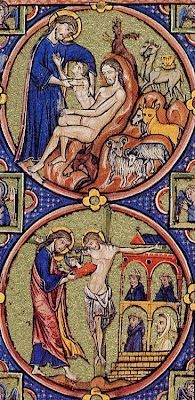I have visited your NYC office/library in the C.G.Jung Center several times. I wondered if you have personnel who might comment on the following idea? Gary Regester
Diagram, top left: From page 244, Marija Gimbutas, The Civilization of the Goddess, Harper, ©1991 -- “An even more esoteric symbol of the womb of regeneration is the bull’s head or skull (bucranium). The similarity of the bucranium with the shape of the woman’s uterus and fallopian tubes was noticed by the artist Dorothy Cameron while working with James Mellaart (in 1960-65) at Catal Huyuk (town in Anatolia [Turkey], c. 7000 BC) . A great deal of information on the symbolic role of the bull’s head is revealed by the wall paintings from Catal Huyuk. In many, the bucranium is shown in place of the uterus in the body of the Goddess. This is a plausible if esoteric explanation for the importance of this motif in the symbolism of Old Europe, Anatolia, and the Near East.”
Photo, top center: from Encyclopædia Britannica, Inc. © 1994-2001 - “Bucranium - decorative motif representing an ox killed in religious sacrifice. The motif originated in a ceremony wherein an ox’s head was hung from the wooden beams supporting the temple roof (italics ed.-see next); this scene was later represented, in stone, on the frieze, or stone lintels, above the columns in Doric temples. The motif has been found on painted pottery in Iraq dating from 5000 BC. (Italics - Ed) It was later imported into Bronze Age Crete as part of the bull and double-ax cult, where the bull’s head was decorated with a garland of bay leaves. In Roman examples, the garland of bay leaves was omitted.”
Photo top right: from New Oxford Annotated Bible, NRSV, Oxford Press, © 1994 -John 19.16,34 “So they took Jesus: and carrying the cross by himself, he went out to what is called The Place of the Skull (Greek: craniou topos), which in Hebrew (Aramaic) is called Golgotha. There they crucified him...one of the soldiers pierced (Jesus’s) side with a spear, and at once blood and water came out."
ARAS reply- Dear Gary Regester Thank you for your letter and evocative images! I am afraid we don’t have the time to do research of this kind, however intriguing it might be. I hope you can come in and do this yourself. These are just some things I remember from our files - there is a connection in Egyptian imagery between uterus and cow horns - not bull horns, as far as I know. There is a connection between Christ’s wound and a bleeding (or at least red-colored) vulva suggesting the womb from which the Church was born. We have several images like that. All best wishes, Ami Ronnberg, Curator ARAS (Archive for Research in Archetypal Symbolism) NYC, NY
From image provided by ARAS (left) from the Bible Moralisee(c. 1250): and the caption provided by ARAS (ARAS 5Ek.010) “The sleep of Adam is the death of Christ. The side of the first man constitutes the woman, as the wound in the side of Christ on the cross signifies the Church (Ecclesia), the wife of Christ, the blood and the water of baptism. The comparison between Adam’s sleep and the death of Christ on the cross, the creation of Eve from the rib taken from Adam’s side and the birth or creation of the Church (the Lord’s Bride) from the wound in Christ’s side while He was on the cross is an old typological comparison first made by the earliest Christian theologian: Tertullian, Augustine, Jerome and Avitus. (from 5Ek.573) In Christian iconography, the wound becomes the spiritual vulva-womb from which Christ is shown literally giving birth to His Church, thereby strengthening the concept of the androgynous mature of Christ, which was suppressed by the church authorities.”
Click on photo, left, to enlarge.


No comments:
Post a Comment